In this episode of #vted Reads, I return to my old stomping grounds at Green Mountain Union High School. I’m talking with school counselor Ally Oswald, about the realities of reaching and teaching students in poverty. Reaching and Teaching Students in Poverty is also the title of a 2013 book by educator and reformer Paul Gorski. And we’re going to use Gorski’s text to identify some concrete strategies to help us, as educators, move from wishful thinking to direct action. Our students need us, and we all know they’re worth it.
So let’s roll up our sleeves and figure it out.
Let’s chat.
Jeanie: I am Jeanie Phillips and welcome to #vted Reads. We are here to talk books for educators, by educators, and with educators. Today, I’m with Ally Oswald. We’ll be talking about Reaching and Teaching Students in Poverty: Strategies for Erasing the Opportunity Gap by Paul Gorski. Thanks for joining me, Ally. Tell us a little bit about who you are and what you do.
Ally: Thanks, Jeanie. It’s great to be here. I’m a school counselor here at Green Mountain in Southern Vermont. I’ve been here for about 10 or 12 years now. My husband is an educator in the building. My two sons come to school here so, this is really a family affair.
We’ve been reading this book as part of a group of teachers from our district, as a study group. We meet once a month and discuss a chapter. It’s really helped me learn about the wealth gap. To learn about how we think about students in poverty. The stereotypes that get associated with families and really question my own practices. It’s been really great to be a part of that group.
How poverty shows up in Vermont schools
Jeanie: You are the perfect guest then for us to dig into this book and think about what action it calls to us in our Vermont schools. Thank you so much for joining me.
So, Paul Gorski begins this book by dispelling the myth that public education is a great equalizer. He says, that’s what we want it to be, but that’s not how it works out. And sighting just countless research, he begins with this,
Students from poor families continue to be subject, on average, to what Jonathan Kozol has called the savage inequalities of schooling. The examples of these inequalities are numerous. Poor students are assigned disproportionately to the most inadequately funded schools with the largest class sizes and lowest paid teachers. They are more likely than their wealthiest peers to be bullied and to attend school in poorly maintained buildings. They are denied access to the sorts of school resources and opportunities other children take for granted, such as dedicated school nurses, well-stocked school libraries, and engaging pedagogies. In fact, by these and almost every other possible measure, students from poor families, the ones most desperate to find truth in the “great equalizer” promise, appear to pay a great price for their poverty, even at school. Of course, these conditions are not the fault of teachers, who are often are blamed unjustly for their effects. In fact, teachers who teach at high-poverty schools, as well as an increasing number of their colleagues at all public schools, too often are themselves denied access to adequate resources.
I wondered Ally, as a school counselor in Vermont School, do you see this playing out in your experience? That schools are being blamed for the effects of poverty over which they have no control.
Ally: Yes. I mean, I think it’s really interesting here in rural Vermont, because there’s not a whole lot of coordination of services between towns and so, schools become the community centers. They become the hub where people come to expect services. Expect food and clothing. The schools are the one place where we can provide those services, because we have access to families. We have access to students and we do have the funding to do that.
I worry about our students in poverty here in Vermont. Especially because housing is so hard to find. Long term housing is so hard to find. I think that students often have to leave schools and transition to different schools. That really gets in the way of their learning.
It just seems to be present all the time. As I’m sitting with students in my office and I’m reading this book, I keep seeing evidence where poverty is getting in the way of students being successful in school. Things like when kids are being evicted from their home, that’s definitely a stressor. When kids don’t have access to food, that’s definitely a stressor.
Health care, I had a student tell me that their parents had to decide whether they’re going to get their wisdom teeth pulled. If they were going to do that, they were going to have to sell their car, or dad was going to have to lose his second job because their family was making too much money to on Dr. Dinosaur. These things are present all the time in our Vermont schools.
Jeanie: Right. While teachers can be there for students in so many ways, we can’t make sure kids get adequate health care.
Ally: Yes.
I think that’s what great about this book is that it allows us to understand sort of the full spectrum of how these injustices sort of reoccur both in and out of school for families.
Our job as taking care of kids like, we just have to be aware that these things are at play. At least we can’t perpetuate these stereotypes and these biases that we have. We work to serve kids and remove these obstacles and remove these barriers.
Jeanie: Yes. So, let’s get into that.
Ally: Yes.
The transformative power of educators
Jeanie: The mission of Gorski’s book is really to expand our capacity to teach for class equity, as he says. He starts with a really awesome quote. I thought I’d ask if you could read it. In my book, it’s on page five.
Ally: He writes,
I also wrote it because I believe in the transformative power of educators, perhaps not always as the frontline people in the struggle to end global poverty (at least not on their own), but as people committed enough to walk into classrooms and schools full of students, dedicated to do the right thing by each of them despite all the challenges.
Jeanie: We see you, teachers. We know that you want to do right by kids. We just want to honor you at the very start of this. Even as we’re digging into things we might do differently or ask you to look at differently, we see you and your vision to be there for kids. To help every kid learn.
Ally: Schools are full of educators who care and want nothing but the best for these kids despite what kids actually think what their teachers think about them.
I have yet to meet educators who don’t want the best for these kids. So, I really believe in the power of educators coming together and understanding these issues deeply and working towards solutions.
Jeanie: Yes. I have yet to meet an educator who doesn’t work their butt off for kids, who doesn’t work so super hard. We just want to honor you from the beginning. I think Gorski does that too. He sees you and knows that you work hard and that you love kids. So, here we go. Let’s see what he’s asking us to think about.
Starting with definitions
Gorski really begins this book with definitions. He defines poverty and working class, middle class. He goes through all these different terms. I was really struck by this. I think we throw around terms like poverty and middle class, right, without really thinking about what they mean.
There are always these studies out for years now in the paper that say, “Most people see themselves as middle class even if they aren’t.” It’s like we all sort of put ourselves in that middle class bucket. I found it really interesting that Gorski starts with definitions and what he means in this book in order to be more precise.
Ally: Yes. To really clarify who the injustices are happening to. How it’s been designed and framed in the last 30 years in terms of politics. I think that really plays into how we fund things and how we make decisions about policies. All of those things.
Language is important.
He talks about how important language is in his text and framing the language.
Jeanie: Yes. We’re going to get to that more because he talks about a strength-based approach to language too. I just found this so interesting because it’s really easy to be unclear. That causes like obfuscation, right? If we’re unclear, then what are we really talking about.
It’s really nice that he starts this book with some real clarity about what he means when he says working class, and middle class. He talks about the owning class. He talks about wealth in ways that are different than I’ve seen in other places. I just appreciated his frankness about that.
… and numbers
Ally: Can I point out some statistics?
Jeanie: Yes, please.
Ally: Is that okay?
Jeanie: Yes.
Ally: I’m going to turn to page 41 in my copy.*
A record 47 million people in the United States live in poverty, about 15% of the population. Actually, that figure is based on that government standard for poverty line income we explored earlier, which is, for example, $24,600 for a family of four. Another 30 million are living just above the poverty line, in constant danger of dipping below it. That’s 77 million people at or near the poverty line in the United States alone.
I just think it’s really important to know that the poverty line in the United States is $24,600 for a family of four. I don’t know about you, but my family of four is struggling to get by on quite a bit more than that. So, I’m wondering why these numbers are these numbers. Who benefits from the numbers being this low?
The fact that we have another 30 million people living just above that line and are constantly in danger. He talks about us being an emergency visit away from poverty.
Jeanie: Yes. I don’t know many educators living a lush life either, right?
Ally: Right.
Jeanie: On their salaries and yet, we are as educators formally in the middle class. Even if we weren’t middle class growing up, we’re middle class now by virtue of being educators. Yet, most educators I know have to take second jobs or think about how to make ends meet.
Unequal access
Ally: He talks about how poverty… so, in public schools, we say that everybody has equal access to things, right? But, when we talk about wealth. Kids actually don’t have equal access, right? Every summer program that my kids are signing up for, costs money, right? I’m fortunately in a place and I have family who can help pay for those things.
But, my kids are learning math this summer at camps. So, of course, they’re going to come in better prepared next year. Other kids don’t have access to those kinds of camps. I think VSAC in our State does a great job of trying to reach out and provide services for kids who are first generation and who fall in this poverty line. But, like what I just said, that $24,600 annual income, if that’s our basis, then we’re missing out on a whole lot of kids who need some extra supports.
Jeanie: Yes, absolutely. In that way, just like some families are just missing out on Dr. Dinosaur. You know, Ally? This isn’t in the book, but it makes me think about lately the news has been full of talk about how the economy is so strong.
I’ve got to tell you, every time Marketplace comes on NPR, I turn it off because I’m a little ticked off that our measure of economic success is all wrapped up in the owning class, as Gorski would refer to them, and how much they’ve traded stocks. Like if our measure is only in the Dow.
I want us to measure economic progress by how many children are living in poverty.
I want to know the number of kids who went without a meal on an average day as a measure of economic success. And I want to know how many families had to make really tough choices between medicine and food. Like, I want our measures of economic success to not be wrapped up in the owning class, but to be wrapped up in the working poor.
Ally: And the number of jobs that are available. I keep hearing that that number is so low right now. It’s because people are working two or three jobs to get by. That’s not the measure of how successful we’re doing.
Quite frankly, we’re not taking good care of our children right now. We need to invest money in feeding our kids, in providing preschool, education for our kids.
We’re here to talk about the book. I’m not going to go on a political rant, but this book helps me see these small injustices that happen every day, right?
Kids can’t… our food service people do a great job getting people access to food here on campus, but the fact that a family has to fill out a form to get access to free food. Why aren’t we just feeding every kid? Why do they have to… he talks about showing their poverty or… I forgot the word he uses now, but I’ll see if I can find it.
But, we’re asking kids to like present their poverty for food. Let’s just feed everybody. What’s the harm in that? How much would that really cost us? I’m sure that we can find money to feed kids in schools, right?
Jeanie: Yes. It’s like demonstrating your poverty.
Ally: Yes.
The Equity Literacy Framework
Jeanie: Yes. I’m sure we can talk about this for a long time. I actually think that Gorski’s point is that we have to act up in society if we want equitable conditions in schools. We’ll talk about that as we begin to delve in to the equity literacy framework that Gorski outlines.
I really want to spend some time on this. Let’s do a pair reading Ally. I’ll read one and you read two, et cetera. Because there are four abilities of equity literacy. The first ability is:
the ability to Recognize both subtle and not-so-subtle biases and inequities in classroom dynamics, school cultures and policies, and the broader society, and how these biases and inequities affect students and their families
Ally: It’s recognizing these small injustices that are happening.
Jeanie: Yes. What’s number two?
Ally: It’s about responding.
the ability to Respond to biases and inequities in the immediate term
He says, it’s having the skill and will to call it out when you see it happening in schools.
Jeanie: Yes. Number three is:
the ability to Redress biases and inequities in a longer term, so that they do not continue to crop up in classrooms in schools
Not only do we have to recognize them and respond right in our classroom in the moment, we’ve got to figure out what’s causing them.
Ally: Right. Understand where it’s coming from and change the system. Like, consciously find solutions that solve the problem and not further perpetuate the inequities.
Jeanie: Yes. Number four?
Ally: Number four is:
the ability to Create and Sustain a bias-free and equitable learning environment
Doesn’t that sound amazing?
Jeanie: It sounds amazing. It sounds aspirational.
Ally: It does.
Jeanie: I think that you and I both saw Paul Gorski speak at a School Reform Initiative Fall Meeting. I’m not sure if it was the same one, but this is reminding me of a story that you and I both love from one of those fall meetings.
Pulling babies out of a river
The story was this, there’s a person standing by a river. They start seeing these babies coming down the river. First one baby, so they pulled the baby out of the water. Then, another baby floats down the river and they pull that baby out of the water. Then, another baby, and they pull that baby out of the water. The person with them goes running off, “Wait, wait, where are you going?” There are all of these babies, right?
The person that runs off said, “I’m going to find out how come these babies are getting into the river in the first place.” In a way, number three redress biases and inequities in a long term, is about figuring out why the babies are in the river in the first place. I know that story resonated for you because I know you as a school counselor feel like you’re yanking babies out of the river.
Ally: I do.
I feel so helpless in this current system to be able to provide what children need.
Nothing is more frustrating in my job than… I get to know kids and be with kids through really tough times. I feel like that’s something that I do really well. I’m proud of the fact that I can sit with kids in their grief and in their struggles.
But it would be so satisfying to find ways to help them not feel like their suffering so much. To find solutions so that they aren’t ashamed of their lives. So that they feel empowered to become these amazing people that they are. I want them to see that.
Jeanie: I wanted to be able to unpack the equity literacy framework. I wondered if you would play along with me. I chose an example that’s a little easier than poverty, that I think is a little clearer. I’m going to lay out a situation, a scenario if you will. Let’s see if we can figure out what it would look like to use these four abilities to get underneath of it.
Ally: Okay.
Applying the Equity Literacy Framework to school dress codes
Jeanie: Here’s my scenario. It comes from real life. This is not made up. When I was a librarian here at Green Mountain, I heard… this is actually not unique to Green Mountain actually. I would suggest almost every school in Vermont probably has this same issue and across that country.
I would often hear kids, female kids, girls talk about the dress code. They were really annoyed by the dress code. I would hear some girls say, “Oh well, if you’re skinny, you can get away with dress code violations, but if you’ve got a little flesh on you, you can’t.” Or I would hear, “None of the boys ever get called down for dress code violations. If they do, they just have to turn their shirt inside out because it has something on it.”
So, I would guess, that if we looked at dress code violation data in almost any school in Vermont it is disproportionately affecting girls.
If we go through this framework, the ability to recognize both subtle and not so subtle bias, what do we see?
Ally: Yes, I think we see girls in half-tops who are getting called down because they are a distraction to other people, right? They are a distraction to boys or other adults in the room. We’re not really… the first recognition is that, that’s sort of unjust. She’s not responsible for the distractions that are happening in the classroom.
Jeanie: Yes. When my son was in middle school many years ago now. A lot of the boys in his class tried to get called out for dress code violations and couldn’t. Meanwhile, girls were shopping at the stores available to them, buying the clothes available to them and they couldn’t wear them to school.
In order to meet the dress code regulations at his middle school, those girls had to go buy clothes at like, old lady shops. Shops that I shop at, right? Not fashionable teenager wear.
It was almost impossible sometimes, especially the short requirement. That the shorts had to be longer than your fingertips. Pity that poor tall girl with the long arms and the long legs, right? She always ended up in the office for a dress code violation. These were often families who had money to go buy clothes. Imagine how challenging it is if your wardrobe is limited because of the income of your family.
Ally: I would say that this is… there’s also an unjust piece to this about kids in poverty because I often see the kids who are well off or who are popular, well put together wearing real skimpy stuff and nobody calls them out. Where it’s a red flag if one of the kids who often gets in trouble, who might be a little bit on the larger size, who is more noticeable as a student on… at somebody’s radar gets called out more often for it than the kids who are well behaved in our school. I think that that’s unjust as well.
Jeanie: Yes.
I call that the red sports car, having been the mother of a red sports car. The red sports car gets more speeding tickets because it’s more visible.
We do have those kids who stand out and get in trouble because then they have a reputation for getting in trouble. We unjustly call them out for wearing the same thing that somebody else is wearing.
There’s all sorts of ways we can recognize both subtle and not so subtle bias about who’s getting called out. I would say just the disproportionate number of girls that get called out for dress code violation should be a flashing red light that says something’s wrong with our policy if only girls are getting in trouble.
Then, if we move on to set two, the ability to respond to biases and inequities in the immediate term as they crop up in classrooms and schools.
Ally: This is a hard part, Jeanie. This is where I am struggling to find the courage to do this. It’s in those everyday moments when we’re talking as teachers about… well, those parents just don’t care. They won’t take time to come meet and talk about their kid. I think we all know these moments when they happen where they are cringe worthy and I let them slide.
This is about not letting them slide. It’s about having the skill to say… actually, parents of students in poverty care just as much about their kid’s futures as kids from their wealthier peers. Having the skill and will to call it out.
Jeanie: Yes. I also didn’t take a very courageous tack. Now that I’m no longer employed by a school, I can honestly say that my response to what I deemed as sexist dress codes was just to ignore kids’ clothing. Like, I didn’t call. I never once reported a kid for a dress code violation. Because I felt like the policy was not worthy of being implemented. Not a very courageous move. Not really a response that changed anything, but that was my response.
Now, if I could go back and have a do-over, I might respond differently. I might actually seek out and get a group of girls to go with me to the principal’s office and say, “Hey, let’s have a look at this dress code. Let’s talk about it.”
Ally: And really get to the root of what the problem is.
Who is affected? How are they affect… what is the problem? I feel like in education so often we go and thinking, making all kinds of assumptions about what’s at play and putting a band-aid on things. Instead of really deeply looking at and figuring out what the problem is.
Then, practical solutions to that problem.
Jeanie: This is an example I think where band-aids are prevalent because I remember a staff meeting here at Green Mountain about the dress code. One of the things that I think we can all agree on is that not one of us wants our young women to be preyed upon by predators outside of this building.
Like, we’re genuinely concerned for their safety. So we want them to dress appropriately so, they don’t draw that kind of attention to themselves and that they don’t get in trouble. That’s a legitimate concern for kids that we don’t want them to get hurt.
But unfortunately, what we’re demonizing is girl’s bodies instead of a culture that preys on young women and that’s really problematic when we make girls feel like their bodies are shameful or should be hidden when the real problem is elsewhere.
I remember having that conversation. I remember feeling like… obviously, I don’t want these girls to be assaulted. I also want them to feel free in their bodies.
Ally: Mm-hmm. And feel good about themselves.
Jeanie: Yes.
Ally: And powerful, right?
Jeanie: And powerful. That gets us to that next ability.
The ability to redress bias and inequities in the longer term. This is where I feel like activism about rape culture and calling out that women are not responsible if men and boys are distracted by their bodies. That women have a right to their own bodies. That their bodies are their own. Men too, by the way, your bodies are your own too.
Ally: Yes.
Jeanie: So, that gets to that. This is where I think Gorski is asking us really to step up beyond what’s in our control in our classrooms and schools and address larger societal problems. Because they show up so often in our schools, right? So rape culture shows up in schools. Even if it doesn’t originate in schools.
Ally: Right.
Advocating for young people
Jeanie: Yes. It’s complicated. He asks us in a way to be political. To be engaged. To be advocates for young people beyond our schools.
Ally: Yes. He does this. I wanted to talk about this at the end, but now might be a good time to talk about it. I’m going to turn to page 87. One of the things that was really helpful for me in understanding, I think I had a really narrow window of what it meant to live in poverty. But, in this chapter, I think… I forget what chapter it is.
He talks about how… it’s chapter six. Class inequities beyond school walls and why they matter at school. So, he helps us… even though we may not be able to change things about food, and housing, and access to medical care, we need to understand that those things are intertwined, right?
Ally:
As we strengthen our equity literacy, we begin to see how these disparities are the result of structural disadvantages.
He talks about livable wage jobs with benefits, health care, adequate and healthy food, stable affordable quality housing, healthy living and working environments, recreation and fitness options, community and social services, quality child care, cognitive enrichment resources and a validating and bias-free society.
Jeanie: That’s a tall order.
Ally: We can do it, Jeanie. I know we can. But when we’re talking about creating and sustaining equitable ways of living and creating educational opportunities for kids that are free of bias. He’s really talking about these things. These things that are outside of our realm of control. It is bigger than us and we have a responsibility.
Building our Equity Literacy muscles
Jeanie: I love how he started with, “As we strengthen our equity literacy skills.” This idea that this is a muscle. That these four steps recognize response, redress, create and sustain feel like a lot.
But, we can start just with recognizing. Then, we can recognize and respond, right? We can slowly build up this muscle like, we would a muscle at the gym, right? We can slowly practice this until we become stronger and stronger.
It starts with just being able to see the inequities that are present for our students.
Ally: I’m going to tell you a story about fall meeting this year. I was at the School Reform Initiative’s Fall Meeting. I was facilitating a small group. It was educators from across the country at all levels who are really interested in this particular conversation, talking about race and inequities around race.
We met and we were all on the same page. Paul Gorski has a second book that’s called Case Studies on Diversity and Social Justice Education, by Paul Gorski and Seema Pothini. In this book, they outline actual case scenarios from school around bias and inequities.
With that group, we started reading three of these. We sat in different groups. We read three and processed what would you do in this scenario?
One was about a student with a physical disability and a field trip. Getting access to the learning that other kids were doing on that field trip when a state park is not allowing a student to go on a particular trail.
We were practicing that muscle. When we were debriefing that, people in the room were like, “Oh my god! I thought I knew. Like, just because I believe in justice doesn’t mean I can call it out and change it.”
It’s so confusing, it’s so murky. What’s the right thing to do in the moment? And then how do I respond. I have to take care of this kid who doesn’t have access. I have to deal with the parents.
Like, there’s so many layers to this that I think it is really good to find a group of people and practice these things with and keep talking about it and thinking about it because there’s no simple solution.
Teachers as life-long learners
Jeanie: Yes. This just makes me think about how as educators, we have to constantly be learners. So many of our schools right now are sort of engaged in some sort of learning around trauma-informed practice. We’re doing work on proficiency. We have to constantly be learners. Our students are changing, but this is just another way in which we have to keep learning. Keep getting better. But we can, we can get better.
Ally: It’s for the benefit for our kids. We want to do better.
We don’t want to hold the stereotypes in our brains and in our hearts.
Educators want kids to be successful. It’s worth it if we can start to explore sort of all these things that we hold to be true in ourselves.
Jeanie: There’s another way in which we can have our students help us with this work too. Christie Nold is doing amazing work where she has kids recognizing bias into her classroom, in the books they read.
A4. Together w/Ss we audit curriculum, shelves, reading logs & ask critical Qs when reading: Who wrote it? What do they want us to believe about the world? Whose voice(s) are missing/marginalized? What would the story be like from the perspective of the missing voices? #ilachat
— Christie Nold (@ChristieNold) December 15, 2017
There’s a school library in Ottaquechee which is engaging students in finding, doing an audit of the library collection to find bias and redress bias.
Our students can be our partners in this work, but also we need to be doing this work.
https://twitter.com/innovativeEd/status/1130117805834231810
10 principles of equity literacy
As if these four abilities weren’t enough, Gorski also outlines ten principles of equity literacy that all seem really important. We don’t have time to talk about all ten, but I wondered if you wanted to talk about one that is especially meaningful to you in your work.
Ally: Yes, I think I’d like to talk about number five.
What we believe about people experiencing poverty informs how we teach, interact with, and advocate (or fail to advocate) for them.
One of the truths that he explores over and over in this book is that the most powerful change a teacher can make or the most powerful learning that we can have is this recognition that we hold stereotypes about people of poverty. We have those and we need to challenge those. We need to look at those and understand them so that we can challenge them.
Because the biggest shift that can happen for educators is if we do this. If we believe in students experiencing poverty and have high expectations for them. Believe in their power, then we can help them be successful.
He talks about no amount of professional development, no books, or number of pencils you provide is a substitute for shifting your beliefs about students in poverty.
Jeanie: Yes. It’s like starting with your heart before you move to your head. I’ve been thinking a lot about how in education we try to shift practice without shifting beliefs. This is really important. What we believe in our hearts shows up in our bodies, in our heads, in our brains, right? Comes out of our mouth.
Ally: Right.
Jeanie: So, we have to believe that all students can learn. We have to believe that all students are doing their best. That makes a huge difference. That really resonates for me.
Number eight. These all stand out for me. But number eight, I think ties in really… these all tie in together too. In my book it says,
Equitable educators adopt a resiliency rather than a deficit view of low-income students and families.
Equity illiterate educators recognize and draw upon the resiliencies and other funds of knowledge accumulated by poor and working class individuals and communities and reject deficit views that focus on fixing disenfranchised students rather than fixing the things that disenfranchise students.
For me, this is all about shifting my language from a deficit-based vocabulary to a strengths-based vocabulary. That is constant work. I think I used to use words like, I think I used to refer to students in ways that I thought was really sensitive to them, but actually was further marginalizing them, right?
So, I tried to change my language to be more strength-based. That ties in with what I believe. It helps me more adequately express what I believe and also shifts what I believe when I use a different language.
So, the title of this book is a perfect example. For years, we’ve heard about the achievement gap. Kids of color are not achieving at the same level as white kids. Kids in poverty are not achieving at the same level.
When we call it achievement gap, then we’re blaming the kids or their families. When we call it an opportunity gap, the implications of having different opportunities, a gap in opportunities if you’re poor turns that on its head.
Ally: Right. It completely shifts your thinking when you change the language and you frame it a different way.
Jeanie: Yes.
Ally: He does that with the term generational poverty. We have this term generational poverty that we often use. He changes it to “generational injustice.” So generations of people having their lands taken away. Having their rights stripped. Not allowing access to purchasing things, purchasing land, owning land.
How you talk about things matters.
Do you mind if I find that place in the book?
Jeanie: Go ahead. I would love for you to share that. I think words do matter. Generational poverty makes it sound like we’re passing poverty down, right? Like, this is your inheritance. I was poor, so now, you’re poor. Generational injustice points to what’s really happened, that systems have made it impossible for certain groups of people to accumulate wealth.
Ally:

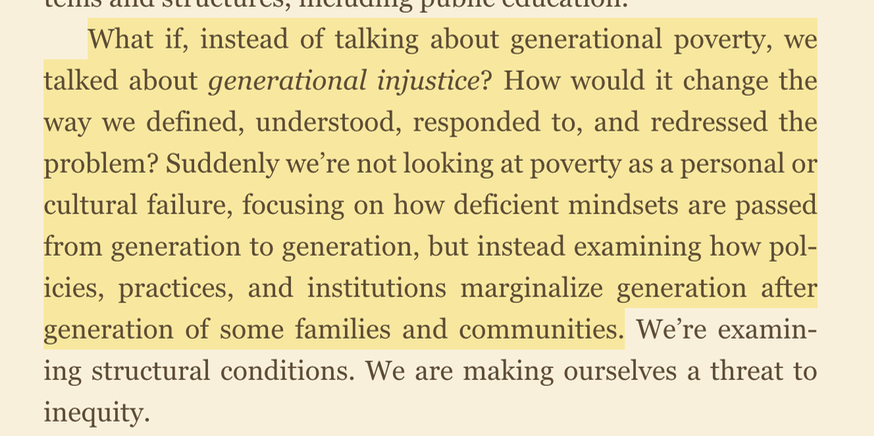
Jeanie: Thank you for sharing that. That really speaks to me about a question that I… you know I ‘m very fond of questions. A question that I often… that sits in my tool kit for equity is this question of… especially around policy is, is this policy trying to fix people?
Because if the answer is yes, it’s likely an inequitable or inadequate policy, right? Is this program trying to fix people?
If we’re trying to fix people, we’re part of the problem, right? What we need to do is fix systems.
As long as we’re focused on fixing people, we’re avoiding or ignoring the real problem which is systemic inequities, systemic biases that create the disenfranchisement, that create the inequities that show up. That really shines up my question for me and make me think about it more. About how that question can be used as we’re designing policy or procedures in schools.
Ally: He also says, and I agree with him when he says, that students know. Students know if you’re pitying them. They know if it’s a band-aid. They know if it’s really getting to the root of the problem or if it’s unjust. If you wonder about that, if you just ask kids like what’s going on? They’ll tell you.
Jeanie: Yes. Nobody wants to be fixed. Don’t tell me I’m broken, don’t pity me, don’t try to change me. Change the systems that create the inequities that make it hard for me. Yes, thank you for that.
Dismantling the myths of the culture of poverty
Gorski spends a whole chapter dismantling the myths of the culture of poverty.
Ally: And really addressing those stereotypes that are common stereotypes of families in poverty.
Jeanie: That section, in particular, you and I, that’s also posted as an article online. That section that dispels common stereotypes about poor families. That’s a really powerful section. You and I have used that in a Collaborative Practices course we co-facilitate to help people look at bias that they have unconsciously held.
Reading and reflecting on this – Five stereotypes about poor families and education http://t.co/HnukEyw4iE
— Chris Wejr (@ChrisWejr) October 28, 2013
We found that to be really painful in a lot of cases for our teachers who are like, “Oh, shoot! I had no idea.” Painful but fruitful that teachers are really having to scrutinize their own beliefs in ways that can be really uncomfortable.
I wondered if you wanted to talk about a particular stereotype that stands out for you from that section.
Ally: I actually am reluctant to read any of these stereotypes because I think they perpetuate, they further perpetuate the story.
What I got out of this chapter is sort of understanding where stereotypes come from. That there’s an inside group and an outside group. Often stereotypes come from an outside group. They don’t come from the people who are experiencing those things.
All you need is a hint of truth for people to buy into it.
I’m going to read this part at the top of page 72.
we tend to require less evidence, and less accurate evidence, to convince us of the legitimacy of a stereotype about a group to which we do not belong then we require to convince us of a stereotype about a group to which we do belong. Social psychologists have referred to this phenomenon as in-group bias…
Jeanie: Yes. So, it’s who gets to call the shots. Who gets to decide?
Ally: Right.
Jeanie: It’s about power.
Ally: It’s about power. It’s less about what’s true and what’s not true.
When you hear Paul Gorski speak, he has this quiz that he makes you take. So, those questions are sort of jaw-dropping about… I even think he lists them in here. About the things that we believed to be true.

Jeanie: Yes. He calls on us again and again to evaluate those things we believe to be true. He throws a ton of research at us. This book has so many parenthetical citations that it exhausts me a little bit.
The one that stopped me in my tracks when I first read it and that I still struggle with is this idea about linguistic deficiency.
For me, the reason is that I grew up working poor. My family to this day does not speak with Standard American English grammar and syntax. They say words that embarrass me. “Ain’t” probably being the least embarrassing of them, but the way they talk is not the way that I talk.
What I love about Gorski is that he cites so much research that just made me have to rethink my thinking about that. He says,
Linguists roundly reject this superior/inferior dichotomy. Some call it “standard language ideology” in reference to the presumptuous and familiar term “standard English.” According to Kathryn Woolard and Bambi Schieffelin, “Moral indignation over nonstandard forms [of language] derives from ideological associations of the standard with the qualities valued within the culture, such as clarity or truthfulness.” In fact, since at least the early 1970s linguists have bemoaned the ways of which students are taught to misunderstand the nature of language, including the false dichotomy of “correct/proper” and “incorrect/improper” language varieties.
In linguistic reality, all variations of a language and all dialects, from what some people call “Black English Vernacular” to the Appalachian English spoken by my grandma are highly structured, with their own sets of grammatical rules.
This notion that we have, that when kids speak in their home vernacular, they are less intelligent. That shows up for me. Like, I hold that bias and I have to work hard against it.
Ally: I think as educators were in a unique position too because it’s not to say, “This is the only way to do it.”
We can say, “When you are writing a resume, when you’re applying for a job, when you’re writing an email to your boss, this is the way communication happens. In other circles, in other places, this is also powerful language and it’s still valued.
Jeanie: Yes. You said that so well. Folks, I’m going to pull us back to a more hopeful place. Because Gorski asked us to do all this hard work to look at ourselves really closely and the biases we hold. To work on recognizing bias in action and redressing it. He’s really asking us to do a lot and it’s hard work.
But he also has this section where he points out strategies that research has shown to be effective for children living in poverty. Let’s turn to that.
Instructional strategies for equity
Jeanie: There’s some great stuff in there. There’s a great little instructional strategies that work list. Then, he digs into them a little further.
These are good for all kids. Just like good trauma-informed practices is good for all kids.
These eight strategies are great for all kids, including kids living in poverty. Would you read the list of strategies that work for all students, not just those in poverty. Then, we can talk about a couple.
Ally:
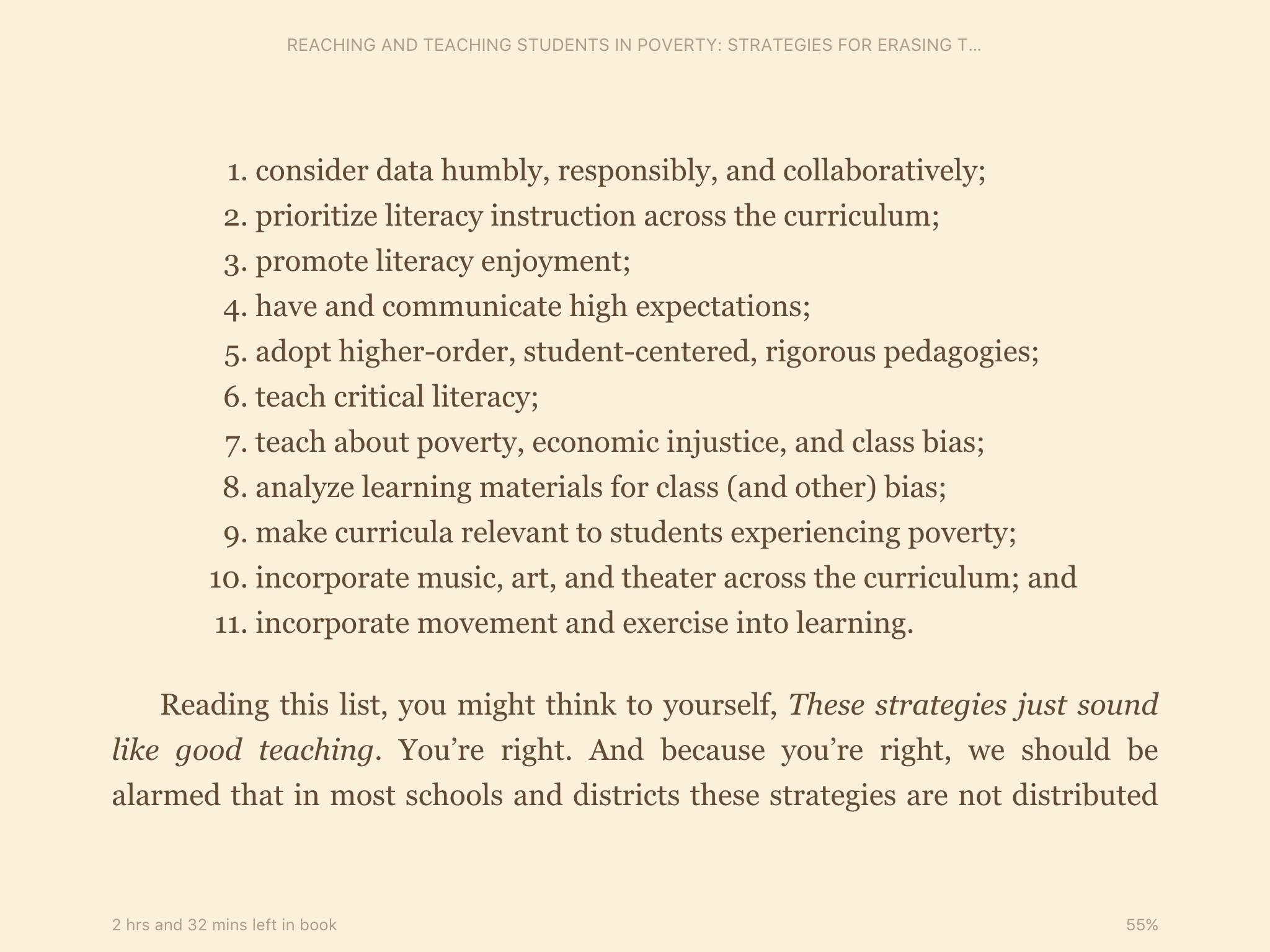
“These strategies just sound like good teaching,” he says.
Jeanie: They are.
For me, I, of course, adore “promote literacy enjoyment.” I hate when reading is turned into a chore. I want it to be fun. As a librarian, it was really important to me that I had books that kids could enjoy. That they felt drawn to. I wanted kids to love the books that they took home, right?
Like, the come to me and say, “Oh my gosh! I love this so much.” That was like my best reward. That combines with the making curricular relevant to the lives of our students. So, it’s really important to me that whether in classrooms or in libraries, that kids be able to see themselves in books.
That means having LGBTQ+ characters in books. That means having kids of color in books. Kids who are refugees in our stories. That we have stories about kids living in poverty where it’s not just demoralizing, right? We don’t have a single story of that, exactly. That we have opportunities for kids to see all different kinds of people like themselves and not in literature and in the curriculum.
It’s super important to me. I’ll give a little shout out to a book I’m in love with right now. Ann Braden’s The Benefits of Being an Octopus. It’s a great opportunity for kids to see their strength and resilience in a character, Zoey, who is experiencing poverty and some abuse in her life.
What rings true for you out of this list?
Ally: I love the last two about incorporating music, art, and theater across curriculum and incorporate movement and exercise into learning.
I think when kids are able to be physical on their bodies that the learning sticks with them.
But, I also want to draw attention to number one. Because we can do this easily. I want to stress how important this is to educational leaders that we take time to do this. Consider data humbly, responsively, and collaboratively.
Data doesn’t have meaning until we look at it together and make meaning together. Then, create a vision for how we want things to be. I can’t do that by myself as a school counselor. You can’t do that on your own as a librarian. We have to do this collectively.
Jeanie: I think that you’re absolutely right about that Ally. That we need to work together in community to look at data and figure out what the biases are and how to redress them. I would recommend to administrators, and teachers and leaders who are interested in doing this work the book, Solving Disproportionality and Achieving Equity.: A Leader’s Guide to Using Data to Change Hearts and Minds by Edward Fergus.
This book was recommended to me by Jillian at the School Reform Initiative. I haven’t had a chance to put it into action yet, I have a copy and it’s just like this amazing opportunity to dig deep in data. You’re right, it doesn’t have meaning until we start to make sense of it and use it for the good of our students.
Focus on relationships
I also love that you called forth the same thing that Gorski calls forth at the end of his book which is a focus on relationships, right? That we need each other to do this important work. Gorski says,
Every practical strategy in the world will not work if we treat poor and working-class youth, or their families, even in the most implicit ways as though they are broken or some lesser other.
Remember, as we learned earlier, that research has shown that who are what we choose to blame for poverty guides the policies and practices we are willing to implement. In other words, what we believe about low income students, how we relate to them is just as important as how we teach them. In fact, it plays a considerable role in determining how we teach them.
This quote really reminded me of you because having known you and worked with you for such a long time, I know that you have this gift for seeing students, really seeing them. I wondered if you wanted to talk about what that means to you.
Ally: That’s really nice, Jeanie. I think what that means to me, in my own personal work that I do. I’m part of a Courage and Renewal cohort. During that work what I’ve realized is that my… I’m only good at my job when I can show up as my full self.
When I begin to be honest about who I am, with everything that I’m awesome at and also everything that I’m not so awesome at. If I can just be fully available for kids, it’s better for them.
I think fully seeing kids is creating spaces where they too can be their honest self. They don’t have to deal with judgment. They don’t have to deal with shame. That they can be a mess, because we’re all kind of a mess.
I think the more spaces we can create, not just for kids, but for people to be their full selves, the better aligned we’ll be as a society about like what matters to us. We can sort of follow our hearts and trust. Trust the choices that we’re making. To feel powerful about changes that we need to make.
Just even in my own personal stuff, I think we all got caught up in our insecurities and feel like, “Oh, I’ll never be able to do this things.”
When we create spaces for people to explore their full selves, they start to recognize that they have a lot of power. They have a lot of skills and they’re really beautiful. They can make changes and make things happen for themselves.
Jeanie: Yes. I think that the special thing that you do, Ally, is you… by helping kids feel fully seen, they also really trust you. So, they can…so many of the ways in which kids, especially kids experiencing poverty show up in schools is to hide.
You helped them realize they don’t have to hide themselves. That they can come clean about what they need or what’s going wrong in their lives.
Ally: But, can I tell you? It’s sort of terrifying too, right? To hold this trust in a system that doesn’t necessarily work for them. In a system that sort of feels unjust. Like I have to talk to girls about their dress code issues. I have to tell kids that college is really important, right? Like, there are all these scripts that I have as part of being in the education system. I worry about having that. It feels like a huge responsibility to hold that trust.
So, this work around equity literacy is really good for me to make that the stories that I’m… these scripts that I’m using are not holding kids back, are not further perpetuating these stereotypes.
Jeanie: Yes. You reminding me that as educators in buildings, we really have to have a two-pronged approach. Like, we do need to play by the rules of the school even as we may be behind the scenes for kids, we may be talking to administrators, to other teacher and to school boards about why those rules need to change. That we do need to uphold policies even as we’re advocating for changes in them.
Ally: I think that’s where people in the world of equity in schools sometimes get sort of chewed up a little bit is in that, in the place of those two things. Sort of ground up in the wheels of holding and creating space and upholding the principles that are in the foundations of education.
Jeanie: It’s exhausting work.
Ally: It is, but it’s so worthwhile when you get to see students being successful in opportunities that they have.
Access and opportunities, those are what we need to focus on for kids.
That’s what Paul Gorski argues about, access and opportunities.
Jeanie: Yes. Teachers, take care of yourself. We know you’re doing so much. We hope you’re doing a little self-care as well because it’s a lot, as Ally said, it’s easy to get ground up in the wheels of this work.
There is so much more to this book. It’s a thin little book, but there is so much more that we haven’t discussed because it’s such a rich resource. Just chock-full of profound thinking and references to research. I wonder if there’s anything else you’d like to call attention to.
Ally: I don’t think so. I had a lovely conversation with you, Jeanie. I think we covered a lot of ground.
Jeanie: Yes.
Ally: I can’t imagine people want to listen to this. Sorry.
Jeanie: How am I supposed to respond to that? Well, I enjoyed listening to you Ally. You have so many great insights. Thank you so much for joining me on the podcast to talk about this really important book.
Ally: Yes. Thanks, Jeanie for having me.
*Ally quoted from the 2nd edition of Reaching and Teaching Students in Poverty, while I quoted from the 1st edition.


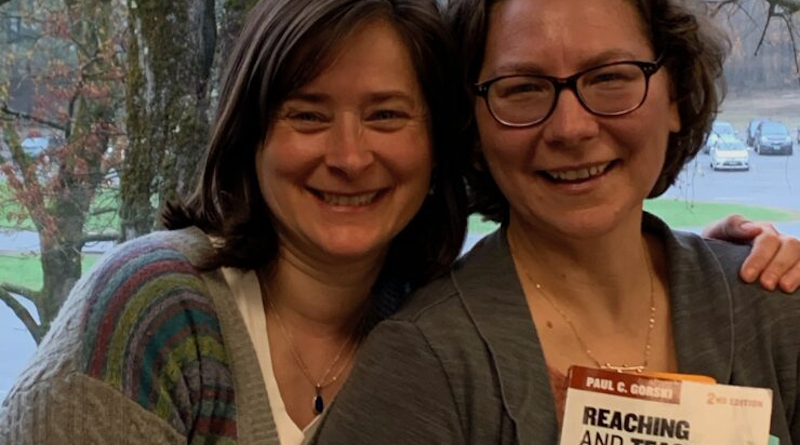


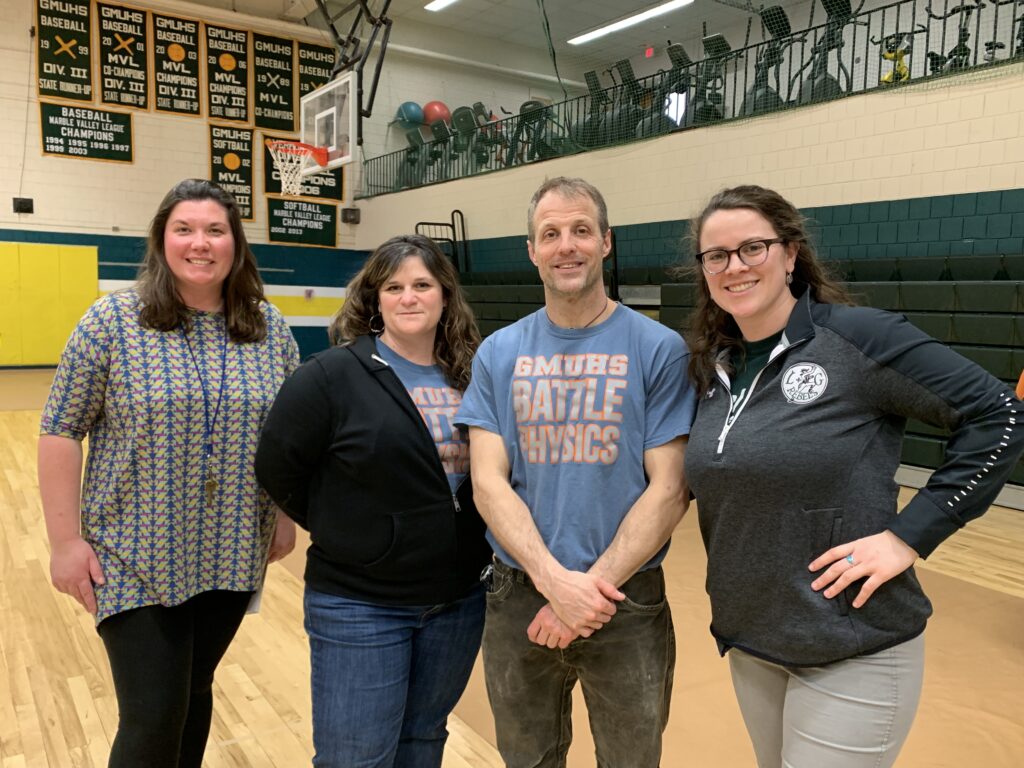
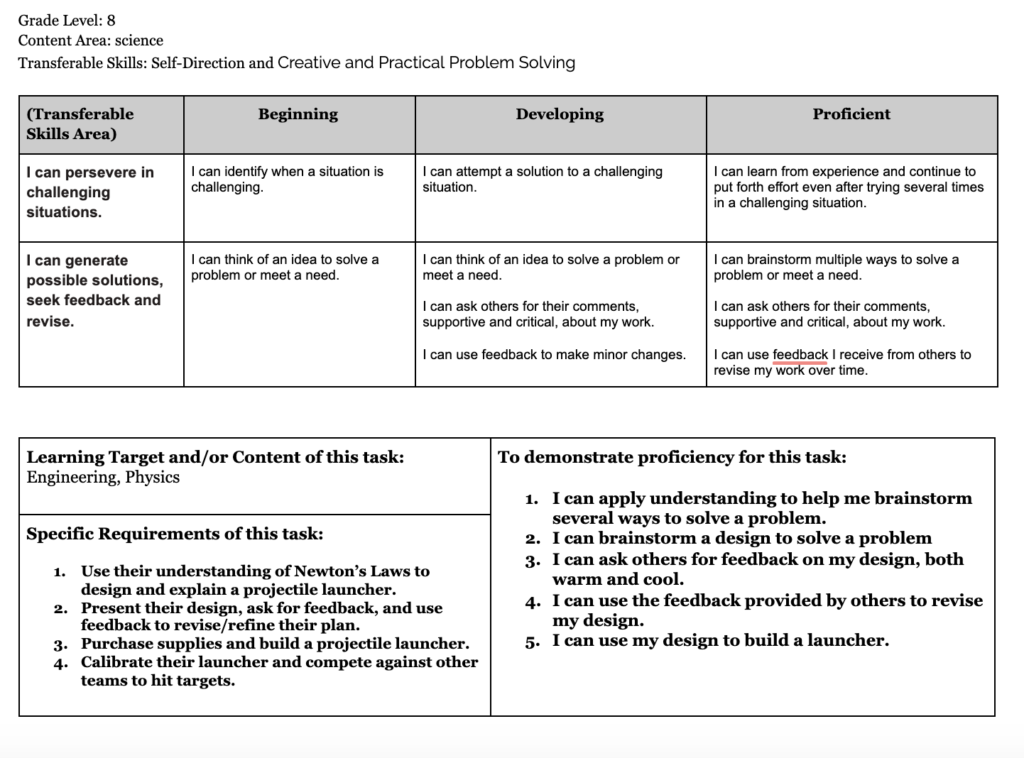
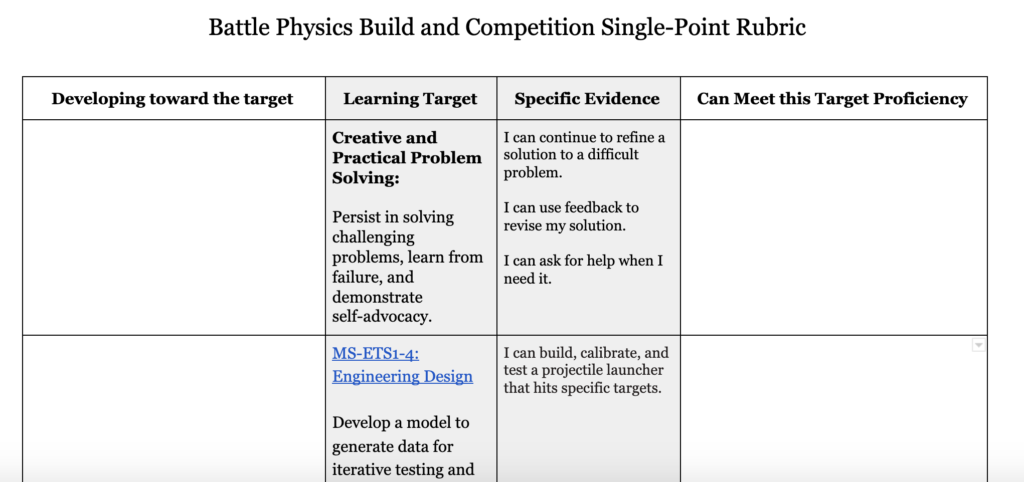
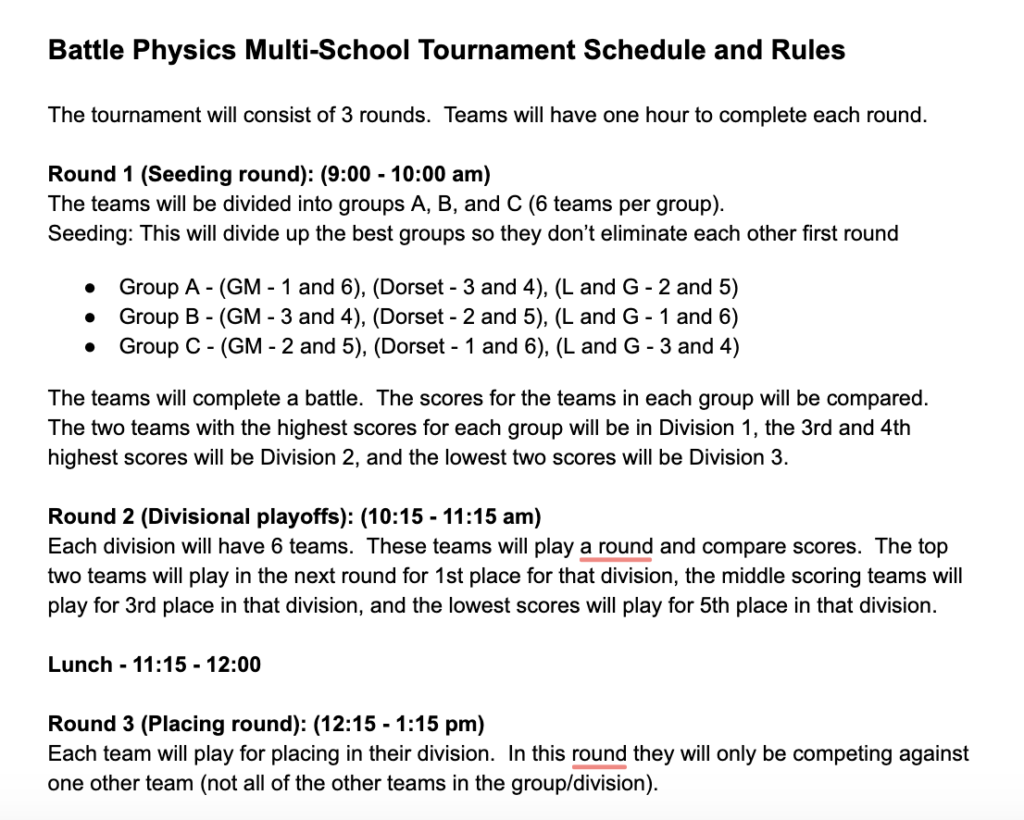
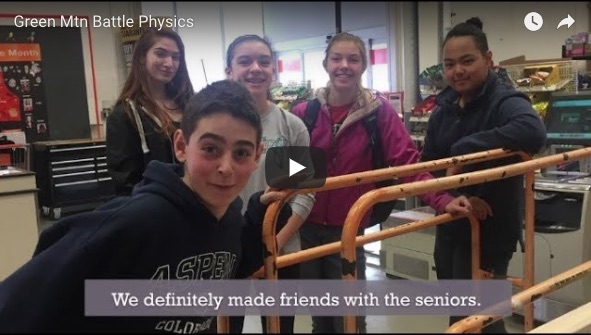
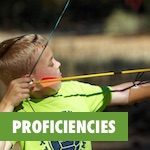 Green Mountain 7th graders and HS physics students apply math and science to a real-world problem: hitting targets. They collaborate in multi-age teams to design and build projectile launchers. Then they calculate trajectories and calibrate their creations before taking aim.
Green Mountain 7th graders and HS physics students apply math and science to a real-world problem: hitting targets. They collaborate in multi-age teams to design and build projectile launchers. Then they calculate trajectories and calibrate their creations before taking aim.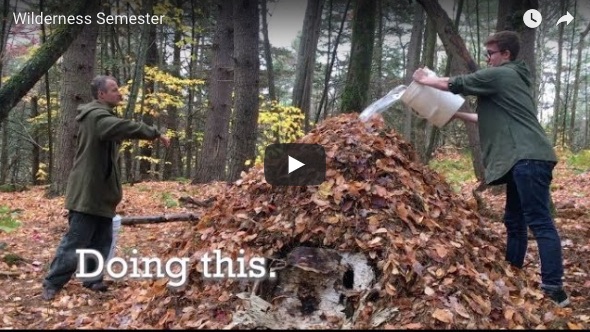
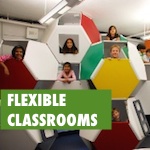
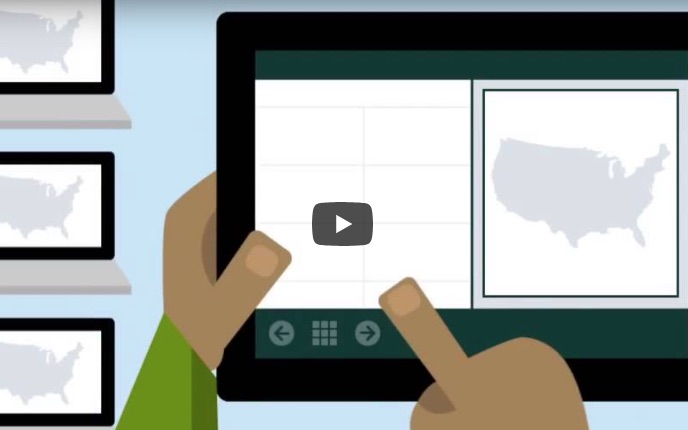
 In a proficiency-based learning environment, frequent, flexible, and transparent assessments become cornerstones of the practice. The importance of
In a proficiency-based learning environment, frequent, flexible, and transparent assessments become cornerstones of the practice. The importance of